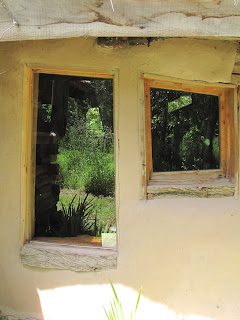The farm where we are volunteering is almost entirely self-sufficient. Each day consists of work, taking mate (the national drink of yerba tea drunk through bombilla straws), reading and working on spanish, and eating. All of our meals are made of whole foods produced on the land we are helping to work. The farm is not much of a commercial venture although they sell raspberries, preserves, and other goods. In additionto helping manage the land we'll be helping to preserve things. Their main crop is raspberries, and raspberry season is coming on in the next few days. The peas are also coming on, and every day we have fresh salads of greens and radishes.
Almost no waste exists on the farm. Just about everything is put to use. One of the biggest tasks this week was cutting the pasto (grass). The grass had grown to a foot or two high, and Claudio was cutting it with a weed whacker. (Jameson got to learn about this task and take over). After a couple of days of drying, we rake it up and collect it in a shed. Claudio will take all this grass to a friend's house who has animals and trade for manure to put on the vegetables. Everything is homemade: the delicious fruit desserts, the composting toilet, the living roof of our casita.
 Our casita.
Our casita.Another task we've had is cleaning the seeds. Claudio and Rosalind collect most (all?) of their own seeds for replanting in the next year. We started with celery, carrot, and cabbage. It was a tedious undertaking to collect the seeds out from the dried plants, but it is a part of gardening that I have not partaken before, and we had a good bit of time to reflect on what it means to carry on the genetic material of the plants that have grown upon that very land. The Chacra is at the base of Cerro (mountain) Piltriquitron, and higher up than the farms in the valley. They have 45 days less of a growing season than other farms in the area. When they continue to collect seeds from their land the plants begin to perform better, as they become more accustomed to the climate.
 The Rio Azul.
The Rio Azul. Jameson crossing the most rickety bridge I have ever seen, over the Rio Azul.
Jameson crossing the most rickety bridge I have ever seen, over the Rio Azul.The people here are experiencing climate change, and it is talked about in the local lore. For example, this year the summer has been very cold, and there have been many late frosts. This year the farm does not have many of the tree fruits that it normally has (apricots and peaches), and few fruits on others. There has also been less snow: two feet previously accumulated in the winter, whereas in recent years only 6-12 inches is common. At the same time, people are skeptical of climate change and some of the drastic changes being called for: who is paying the scientists for those studies and what are their interests.
Another thing of interest is the small-town reaction to the economic crisis. Where Buenos Aires was somewhat incapacitated with runaway inflation in the year 2000, these small towns developed a local economy, created fake bills (but that actually had value) and developed a barter system which enabled people to weather the storm in a much more capable manner than in the throes of the big city. I think that the 'fake' money also occurred all over the country, but the difference is that almost everyone in an area like this is producing, whereas people in BA, like in other big cities, may be working in offices or such and not have a direct produce to offer.
The whole area here consists of funky housing and old cars. Since wood is a big commodity here, there are many log planks, but when they mill them down they just cut in one direction, retaining the bark and the curvy, organic shape of the wood. It lends a soft edge and pleasant ambiance to the buildings.
 The view of Refugio Cerro Lopez, and Lago Nauhel Huapi, in Bariloche.
The view of Refugio Cerro Lopez, and Lago Nauhel Huapi, in Bariloche.We will be here for the next 3 weeks, and it may be hard to write in the blog during this time. Our bus ride from BA to Bariloche was mediocre: next time we may opt for the slightly cheaper bus as dinner and wine were not so splendid, but the seats were big. Bariloche was beautiful but too touristy and expensive for our tastes.
Hola muchachos!
ReplyDeleteLiving roofs, yay! Sounds beautiful and real and fresh and like being on this planet.
I'd love to see pics of the homes there.
What a gorgeous river.
Enjoy -
til next time!
much love
Victoria
Good to hear from you. Wow what pictures! That bridge is amazing. What an experience!
ReplyDeleteMom